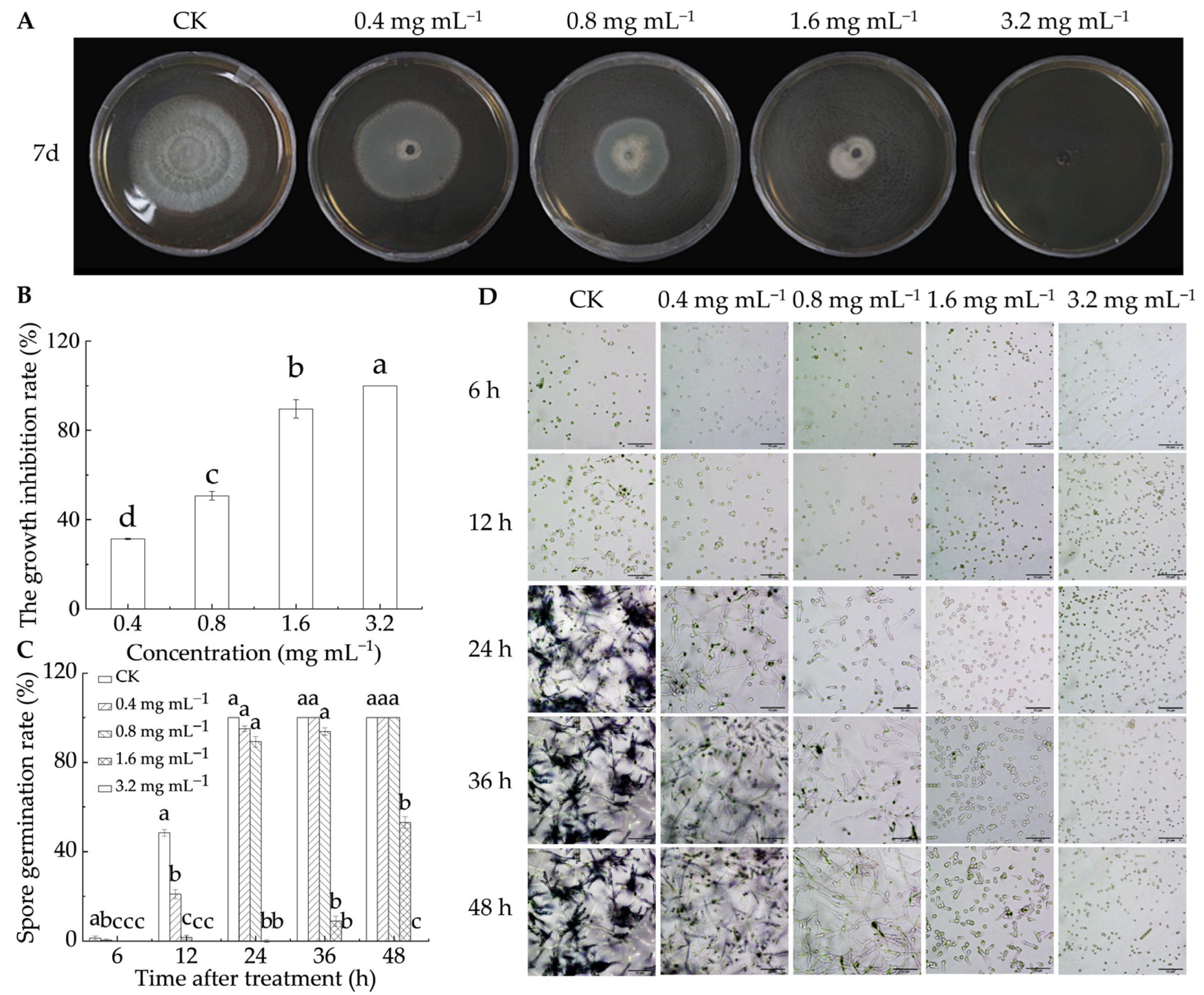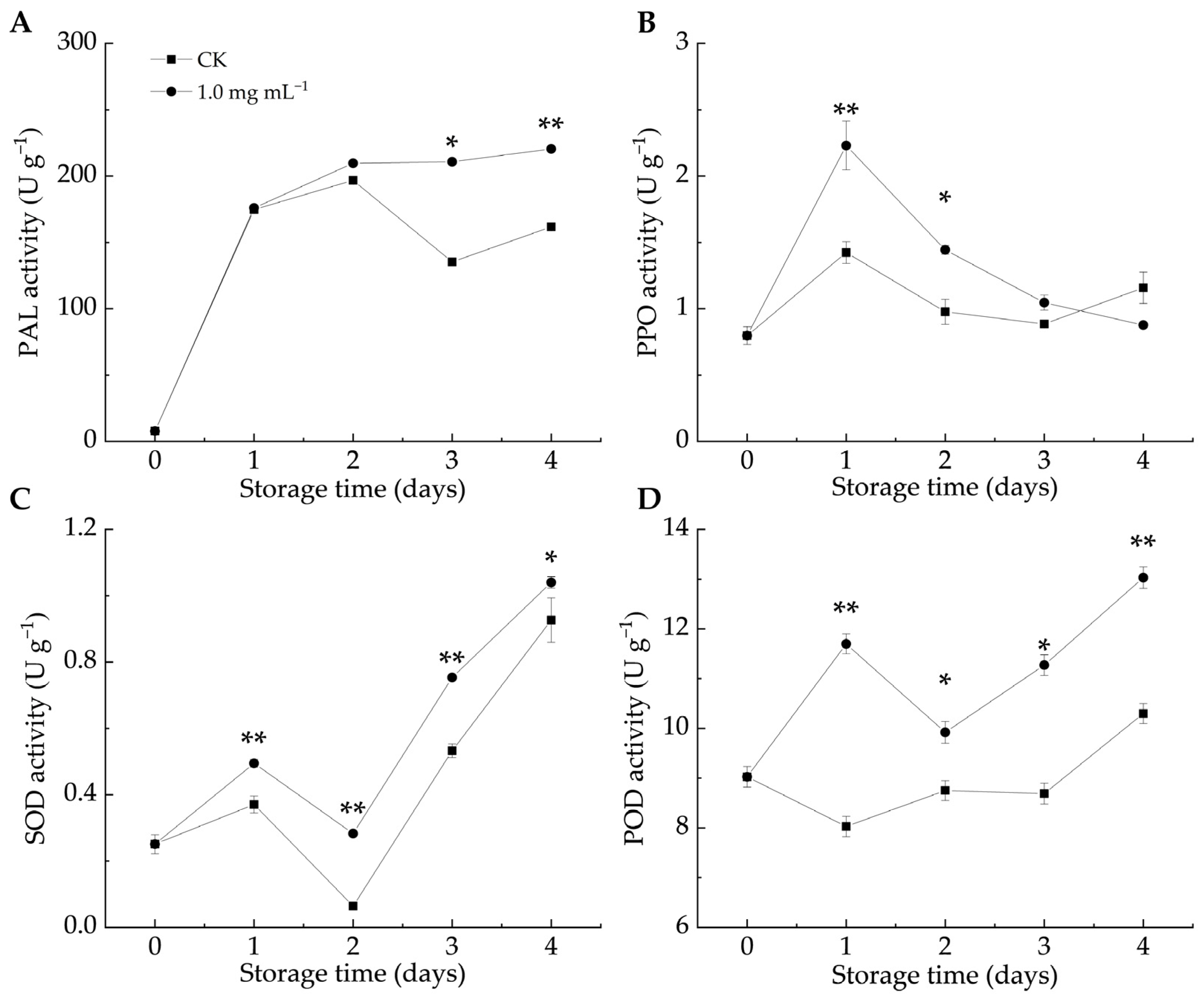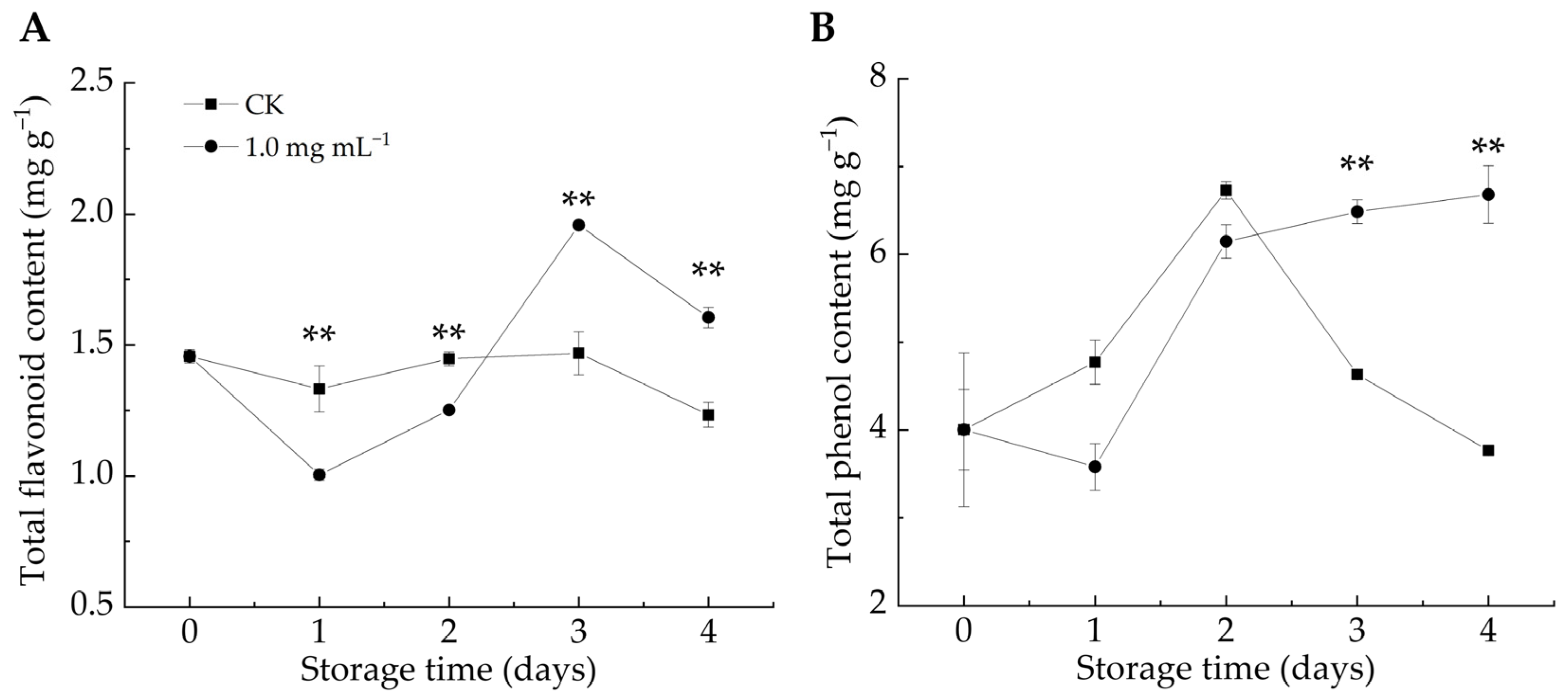Lipoic Acid Enhances the Defense Capability of Citrus Fruits to Blue Mold Caused by Penicillium italicum
Abstract
:1. Introduction
2. Materials and Methods
2.1. Materials
2.2. Measurement of Antifungal Activity and Spore Germination Rate
2.3. Measurement of Relative Conductivity, Total Sugar Content, Protein Content, and Hydrogen Peroxide (H2O2) Levels
2.4. P. italicum Infection of Citrus Fruits
2.5. Malondialdehyde (MDA) Content
2.6. Total Phenol (TPC) and Total Flavonoid (TFC) Content
2.7. Activities of Enzymes
2.8. Data Analysis
3. Results and Discussion
3.1. In Vitro Experiments
3.1.1. LA Inhibited the Growth of P. italicum
3.1.2. LA Damaged Cell Membrane Integrity of P. italicum
3.2. In Vivo Experiments
3.2.1. LA Treatment Delayed the Decay Symptoms of Citrus Fruits
3.2.2. LA Reduced MDA Content in Citrus Peel
3.2.3. LA Increased Defense-Related Enzyme Activities in Citrus Peel
3.2.4. LA Increased TFC and TPC Contents in Citrus Peel
4. Conclusions
Author Contributions
Funding
Institutional Review Board Statement
Informed Consent Statement
Data Availability Statement
Conflicts of Interest
References
- De Vilhena Araújo, É.; Vendramini, P.H.; Costa, J.H.; Eberlin, M.N.; Montagner, C.C.; Fill, T.P. Determination of Tryptoquialanines A and C Produced by Penicillium digitatum in Oranges: Are We Safe? Food Chem. 2019, 301, 125285. [Google Scholar] [CrossRef] [PubMed]
- Ferraz, L.P.; da Cunha, T.; da Silva, A.C.; Kupper, K.C. Biocontrol Ability and Putative Mode of Action of Yeasts Against Geotrichum citri-aurantii in Citrus Fruit. Microbiol. Res. 2016, 188, 72–79. [Google Scholar] [CrossRef] [PubMed]
- Vilanova, L.; Viñas, I.; Torres, R.; Usall, J.; Buron-Moles, G.; Teixidó, N. Acidification of Apple and Orange Hosts by Penicillium digitatum and Penicillium expansum. Int. J. Food Microbiol. 2014, 178, 39–49. [Google Scholar] [CrossRef] [PubMed]
- Talibi, I.; Boubaker, H.; Boudyach, E.H.; Ben Aoumar, A.A. Alternative Methods for the Control of Postharvest Citrus Diseases. J. Appl. Microbiol. 2014, 117, 1–17. [Google Scholar] [CrossRef]
- Chen, J.; Shen, Y.; Chen, C.; Wan, C. Inhibition of Key Citrus Postharvest Fungal Strains by Plant Extracts In Vitro and In Vivo: A Review. Plants 2019, 8, 26. [Google Scholar] [CrossRef]
- Demirci, F. Effects of Pseudomonas fluorescens and Candida famata on Blue Mould of Citrus Caused by Penicillium italicum. Aust. J. Crop Sci. 2011, 5, 344–349. [Google Scholar] [CrossRef]
- Zhang, H.; Wang, S.; Deng, Q.; Zhang, X.; Liao, B.; Huang, J.; Zeng, K. The Effect of Pulcherriminic Acid Produced by Metschnikowia citriensis in Controlling Postharvest Diseases of Citrus Fruits. Pest. Biochem. Physiol. 2023, 197, 105657. [Google Scholar] [CrossRef]
- Lu, L.; Ye, C.; Guo, S.; Sheng, K.; Shao, L.; Zhou, T.; Yu, T.; Zheng, X. Preharvest Application of Antagonistic Yeast Rhodosporidium paludigenum Induced Resistance Against Postharvest Diseases in Mandarin Orange. Biol. Control 2013, 67, 130–136. [Google Scholar] [CrossRef]
- Sánchez-Torres, P.; Tuset, J.J. Molecular Insights into Fungicide Resistance in Sensitive and Resistant Penicillium digitatum Strains Infecting Citrus. Postharvest Biol. Technol. 2011, 59, 159–165. [Google Scholar] [CrossRef]
- Martins, S.J.; Faria, A.F.; Pedroso, M.P.; Cunha, M.G.; Rocha, M.R.; Medeiros, F.H.V. Microbial Volatile Organic Compounds Control Anthracnose (Colletotrichum lindemuthianum) in Common Bean (Phaseolus vulgaris L.). Biol. Control 2019, 131, 36–42. [Google Scholar] [CrossRef]
- Li, T.; Wang, W.J.; Chen, Q.; Chen, J.L.; Zhang, X.; Wei, L.L.; Deng, L.L.; Yao, S.X.; Zeng, K.F. Transcription Factor CsERF1B Regulates Postharvest Citrus Fruit Resistance to Penicillium digitatum. Postharvest Biol. Technol. 2023, 198, 112260. [Google Scholar] [CrossRef]
- He, M.Y.; Wang, Y.; Hong, M.; Li, T.T. Berberine as a Promising Natural Compound to Control Penicillium italicum Causing Blue Mold of Citrus Fruit. Sci. Hortic. 2022, 305, 111370. [Google Scholar] [CrossRef]
- Fogacci, F.; Rizzo, M.; Krogager, C.; Kennedy, C.; Georges, C.M.G.; Knezevic, T.; Liberopoulos, E.; Vallée, A.; Pérez-Martínez, P.; Wenstedt, E.F.E.; et al. Safety Evaluation of α-Lipoic Acid Supplementation: A Systematic Review and Meta-Analysis of Randomized Placebo-Controlled Clinical Studies. Antioxidants 2020, 9, 1011. [Google Scholar] [CrossRef] [PubMed]
- Petkovic, B.B.; Ognjanovic, M.; Antic, B.; Avdin, V.V.; Manojlovic, D.D.; Duric, S.V.; Stankovic, D.M. Easily Prepared Co₃O₄Doped Porous Carbon Material Decorated with Single-Wall Carbon Nanotubes Applied in Voltammetric Sensing of Antioxidant α-Lipoic Acid. Electroanalysis 2020, 33, 446–454. [Google Scholar] [CrossRef]
- Cure, E.; Cure, M.C. Alpha-Lipoic Acid May Protect Patients with Diabetes Against COVID-19 Infection. Med. Hypotheses 2020, 143, 110185. [Google Scholar] [CrossRef]
- Zhang, Z.Y.; Wen, R.; Zhang, W.L.; Ge, N.; Bo, J.W. Efficacy and Mechanism of Lipoic Acid in the Treatment of Reproductive Injury Caused by Perfluorooctanoic Acid. Exp. Ther. Med. 2023, 25, 116. [Google Scholar] [CrossRef]
- Reed, L.J.; Debusk, B.G.; Gunsalus, I.C.; Hornberger, C.S. Crystalline Alpha-Lipoic Acid: A Catalytic Agent Associated with Pyruvate Dehydrogenase. Science 1951, 114, 93–94. [Google Scholar] [CrossRef]
- Gorąca, A.; Huk-Kolega, H.; Piechota, A.; Kleniewska, P.; Ciejka, E.; Skibska, B. Lipoic Acid—Biological Activity and Therapeutic Potential. Pharmacol. Rep. 2011, 63, 849–858. [Google Scholar] [CrossRef]
- Levent, G.; Bozic, A.; Petrujkic, B.T.; Callaway, T.R.; Poole, T.L.; Crippen, T.L.; Harvey, R.B.; Ochoa-García, P.; Corral-Luna, A.; Yeater, K.M.; et al. Assessment of Potential Anti-Methanogenic and Antimicrobial Activity of Ethyl Nitroacetate, α-Lipoic Acid, Taurine and L-Cysteinesulfinic Acid In Vitro. Microorganisms 2024, 12, 34. [Google Scholar] [CrossRef]
- Chen, J.Y.; Yuan, T.; Liu, Z.Z. Supramolecular Medical Antibacterial Tissue Adhesive Prepared Based on Natural Small Molecules. Biomater. Sci. 2020, 8, 6235–6245. [Google Scholar] [CrossRef]
- Zhou, W.Y.; Du, Y.W.; Li, X.S.; Yao, C. Lipoic Acid Modified Antimicrobial Peptide with Enhanced Antimicrobial Properties. Bioorg. Med. Chem. 2020, 28, 115682. [Google Scholar] [CrossRef] [PubMed]
- Shi, C.; Sun, Y.; Zhang, X.R.; Zheng, Z.W.; Yang, M.C.; Ben, H.; Song, K.K.; Cao, Y.F.; Chen, Y.F.; Liu, X.; et al. Antimicrobial Effect of Lipoic Acid Against Cronobacter sakazakii. Food Control 2016, 59, 352–358. [Google Scholar] [CrossRef]
- Wang, K.B.; Jiang, S.S.; Pu, T.; Fan, L.M.; Su, F.W.; Ye, M. Antifungal Activity of Phenolic Monoterpenes and Structure-Related Compounds Against Plant Pathogenic Fungi. Nat. Prod. Res. 2019, 33, 1423–1430. [Google Scholar] [CrossRef] [PubMed]
- Song, W.W.; Fu, X.X.; Cao, D.T.; Liang, X.G.; Xiao, S.L.; Yuan, M.X.; Huang, Y.J.; Zhou, Q.H.; Wei, H.Y.; Wang, J.W.; et al. The Delaying Effect of Clausena lansium Extract on Pear Ring Rot Is Related to Its Antifungal Activity and Induced Disease Resistance. Postharvest Biol. Technol. 2024, 212, 112847. [Google Scholar] [CrossRef]
- Kong, X.; Wei, B.; Gao, Z.; Zhou, Y.; Shi, F.; Zhou, X.; Zhou, Q.; Ji, S. Changes in Membrane Lipid Composition and Function Accompanying Chilling Injury in Bell Peppers. Plant Cell Physiol. 2018, 59, 167–178. [Google Scholar] [CrossRef]
- Chang, D.; Liu, H.; An, M.; Hong, D.; Fan, H.; Wang, K.; Li, Z. Integrated Transcriptomic and Metabolomic Analysis of the Mechanism of Foliar Application of Hormone-Type Growth Regulator in the Improvement of Grape (Vitis vinifera L.) Coloration in Saline-Alkaline Soil. Plants 2022, 11, 2115. [Google Scholar] [CrossRef]
- Shu, C.; Zhao, H.D.; Jiao, W.X.; Liu, B.D.; Cao, J.K.; Jiang, W.B. Antifungal Efficacy of Ursolic Acid in Control of Alternaria alternata Causing Black Spot Rot on Apple Fruit and Possible Mechanisms Involved. Sci. Hortic. 2019, 256, 108636. [Google Scholar] [CrossRef]
- Li, T.T.; Shi, D.D.; Wu, Q.X.; Yin, C.X.; Li, F.J.; Shan, Y.X.; Duan, X.W.; Jiang, Y.M. Mechanism of Cell Wall Polysaccharides Modification in Harvested ‘Shatangju’ Mandarin (Citrus reticulate Blanco) Fruit Caused by Penicillium italicum. Biomolecules 2019, 9, 160. [Google Scholar] [CrossRef]
- Sellamuthu, P.S.; Sivakumar, D.; Soundy, P.; Korsten, L. Essential Oil Vapours Suppress the Development of Anthracnose and Enhance Defence Related and Antioxidant Enzyme Activities in Avocado Fruit. Postharvest Biol. Technol. 2013, 81, 66–72. [Google Scholar] [CrossRef]
- Shang, F.; Liu, R.; Wu, W.; Han, Y.; Fang, X.; Chen, H.; Gao, H. Effects of Melatonin on the Components, Quality and Antioxidant Activities of Blueberry Fruits. LWT Food Sci. Technol. 2021, 147, 111582. [Google Scholar] [CrossRef]
- Zhang, Y.; Huber, D.; Hu, M.; Jiang, G.; Gao, Z.; Xu, X.; Jiang, Y.; Zhang, Z. Delay of Postharvest Browning in Litchi Fruit by Melatonin via the Enhancing of Antioxidative Processes and Oxidation Repair. J. Agric. Food Chem. 2018, 66, 7475–7484. [Google Scholar] [CrossRef] [PubMed]
- Zhao, C.; Zhao, X.; Zhang, J.; Zou, W.; Zhang, Y.; Li, L.; Liu, J. Screening of Bacillus Strains from Sun Vinegar for Efficient Production of Flavonoid and Phenol. Indian J. Microbiol. 2016, 56, 498–503. [Google Scholar] [CrossRef] [PubMed]
- Zhang, Z.; Hu, M.; Yun, Z.; Wang, J.; Feng, G.; Gao, Z.; Shi, X.; Jiang, Y. Effect of Tea Seed Oil Treatment on Browning of Litchi Fruit in Relation to Energy Status and Metabolism. Postharvest Biol. Technol. 2017, 132, 97–104. [Google Scholar] [CrossRef]
- Shewfelt, R.L.; Rosario, B.A. The Role of Lipid Peroxidation in Storage Disorders of Fresh Fruits and Vegetables. HortScience 2000, 35, 575–579. [Google Scholar] [CrossRef]
- Chen, C.Y.; Qi, W.W.; Peng, X.; Chen, J.Y.; Wan, C.P. Inhibitory Effect of 7-Demethoxytylophorine on Penicillium italicum and Its Possible Mechanism. Microorganisms 2019, 7, 36. [Google Scholar] [CrossRef]
- Che, J.X.; Chen, X.M.; Ouyang, Q.L.; Tao, N.G. p-Anisaldehyde Exerts Its Antifungal Activity Against Penicillium digitatum and Penicillium italicum by Disrupting the Cell Wall Integrity and Membrane Permeability. J. Microbiol. Biotechnol. 2020, 30, 878–884. [Google Scholar] [CrossRef]
- Rodriguez, R.; Redman, R. Balancing the Generation and Elimination of Reactive Oxygen Species. Proc. Natl. Acad. Sci. USA 2005, 102, 3175–3176. [Google Scholar] [CrossRef]
- Yang, S.; Tian, L.; Wang, X.; Wu, M.; Liao, S.; Fu, J.; Xiong, W.; Gong, G. Metabolomics Analysis and Membrane Damage Measurement Reveal the Antibacterial Mechanism of Lipoic Acid Against Yersinia enterocolitica. Food Funct. 2022, 13, 11476–11488. [Google Scholar] [CrossRef]
- Figueroa, A.C.; Diaz, M.S.; Turco, M.; Trotta, A.F.; Marino, B.; Soria, N.W.; Beltramo, D.M.; Alasino, R.V. Effects of Antioxidants on In Vitro Growth of Thecaphora frezzii. J. Appl. Microbiol. 2024, 135, lxae306. [Google Scholar] [CrossRef]
- Zhang, X.; Deng, Q.; Gao, X.Q.; Wang, W.J.; Zeng, K.F. Fatty Acid Metabolism and C9 Aldehyde Biosynthesis Are Involved in e-Poly-L-Lysine-Induced Citrus Fruit Resistance to Penicillium digitatum. Pest. Biochem. Physiol. 2023, 196, 105614. [Google Scholar] [CrossRef]
- Zhang, D.; Luo, K.; Wen, S.; Zhou, Q.; Li, B.; Liang, W.; Di, J. Isolation and Identification of Aspergillus spp. from Rotted Walnuts and Inhibition Mechanism of Aspergillus flavus via Cinnamon Essential Oil. Foods 2025, 14, 357. [Google Scholar] [CrossRef]
- Biewenga, G.P.; Haenen, G.R.M.M.; Bast, A. The Pharmacology of the Antioxidant Lipoic Acid. Gen. Pharmacol. 1997, 29, 315–331. [Google Scholar] [CrossRef] [PubMed]
- Xu, F.; Deng, G.; Cheng, S.Y.; Zhang, W.W.; Huang, X.H.; Li, L.L.; Cheng, H.; Rong, X.F.; Li, J.B. Molecular Cloning, Characterization, and Expression of the Phenylalanine Ammonia-Lyase Gene from Juglans regia. Molecules 2012, 17, 526–534. [Google Scholar] [CrossRef] [PubMed]
- Mahunu, G.K.; Zhang, H.Y.; Yang, Q.Y.; Zhang, X.Y.; Li, D.D.; Zhou, Y.X. Improving the Biocontrol Efficacy of Pichia caribbica with Phytic Acid Against Postharvest Blue Mold and Natural Decay in Apples. Biol. Control 2016, 92, 172–180. [Google Scholar] [CrossRef]
- Awan, Z.A.; Shoaib, A.; Khan, K.A. Variations in Total Phenolics and Antioxidant Enzymes Cause Phenotypic Variability and Differential Resistant Response in Tomato Genotypes Against Early Blight Disease. Sci. Hortic. 2018, 239, 216–223. [Google Scholar] [CrossRef]
- Wang, Z.; Pu, H.; Shan, S.; Zhang, P.; Li, J.; Song, H.; Xu, X. Melatonin Enhanced Chilling Tolerance and Alleviated Peel Browning of Banana Fruit Under Low Temperature Storage. Postharvest Biol. Technol. 2021, 179, 111571. [Google Scholar] [CrossRef]
- Liu, Y.; Ge, Y.; Bi, Y.; Li, C.; Deng, H.; Dong, B. Effect of Postharvest Acibenzolar-S-Methyl Dipping on Phenylpropanoid Pathway Metabolism in Muskmelon (Cucumis melo L.) Fruits. Sci. Hortic. 2014, 168, 113–119. [Google Scholar] [CrossRef]
- Zhang, X.; Zhou, Y.; Li, J.; Gu, X.; Zhao, L.; Li, B.; Wang, K.; Yang, Q.; Zhang, H. Pichia caribbica Improves Disease Resistance of Cherry Tomatoes by Regulating ROS Metabolism. Biol. Control 2022, 169, 104870. [Google Scholar] [CrossRef]
- Xu, D.; Deng, Y.; Xi, P.; Yu, G.; Wang, Q.; Zeng, Q.; Jiang, Z.; Gao, L. Fulvic Acid-Induced Disease Resistance to Botrytis cinerea in Table Grapes May Be Mediated by Regulating Phenylpropanoid Metabolism. Food Chem. 2019, 286, 226–233. [Google Scholar] [CrossRef]
- Li, S.; Xu, Y.; Bi, Y.; Zhang, B.; Shen, S.; Jiang, T.; Zheng, X. Melatonin Treatment Inhibits Gray Mold and Induces Disease Resistance in Cherry Tomato Fruit during Postharvest. Postharvest Biol. Technol. 2019, 157, 110962. [Google Scholar] [CrossRef]





| Virulence Regression Equation/(y) | Phase Relation (r) | Median Effect Concentration (EC50) | 95% Confidence Interval |
|---|---|---|---|
| y = −0.357 − 1.483x | 0.858 | 0.574 mg mL−1 | 0.448–0.738 |
Disclaimer/Publisher’s Note: The statements, opinions and data contained in all publications are solely those of the individual author(s) and contributor(s) and not of MDPI and/or the editor(s). MDPI and/or the editor(s) disclaim responsibility for any injury to people or property resulting from any ideas, methods, instructions or products referred to in the content. |
© 2025 by the authors. Licensee MDPI, Basel, Switzerland. This article is an open access article distributed under the terms and conditions of the Creative Commons Attribution (CC BY) license (https://creativecommons.org/licenses/by/4.0/).
Share and Cite
Lu, Z.; Hong, M.; Wang, R.; Feng, Y.; Cheng, S.; He, M. Lipoic Acid Enhances the Defense Capability of Citrus Fruits to Blue Mold Caused by Penicillium italicum. Foods 2025, 14, 987. https://doi.org/10.3390/foods14060987
Lu Z, Hong M, Wang R, Feng Y, Cheng S, He M. Lipoic Acid Enhances the Defense Capability of Citrus Fruits to Blue Mold Caused by Penicillium italicum. Foods. 2025; 14(6):987. https://doi.org/10.3390/foods14060987
Chicago/Turabian StyleLu, Zhihong, Min Hong, Rikui Wang, Yu Feng, Shiming Cheng, and Mingyang He. 2025. "Lipoic Acid Enhances the Defense Capability of Citrus Fruits to Blue Mold Caused by Penicillium italicum" Foods 14, no. 6: 987. https://doi.org/10.3390/foods14060987
APA StyleLu, Z., Hong, M., Wang, R., Feng, Y., Cheng, S., & He, M. (2025). Lipoic Acid Enhances the Defense Capability of Citrus Fruits to Blue Mold Caused by Penicillium italicum. Foods, 14(6), 987. https://doi.org/10.3390/foods14060987






